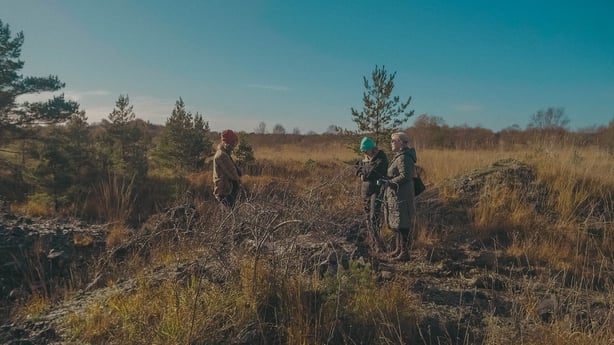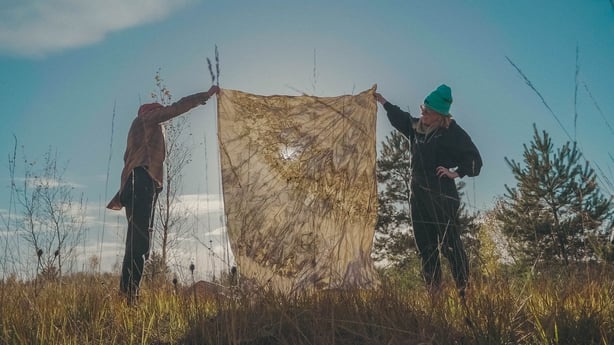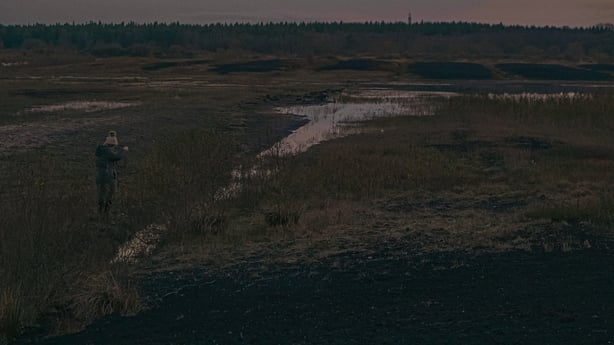For this year's New Music Dublin Festival at the National Concert Hall, Crash Ensemble perform the world premiere of composer Ann Cleare's TERRARIUM.
Below Ann Cleare introduces TERRARIUM, a work that aurally and visually transports its audience through the specific yet universal touch stones of the Irish boglands to a vanished Mesolithic Lake in Co. Offally.
Composed during my time as Artist-in-Residence with Crash Ensemble, TERRARIUM is a new hour-long immersive work, forming the second part of a trilogy of works that I am writing related to significant sites of human and natural history in the Midlands of Ireland, where I live.
The Midlands have always existed in a flux between land and water, and TERRARIUM explores a unique site that encapsulates this ever-changing terrain.
Nestled deep within Boora Parklands in County Offaly, one can find the ruin of a Mesolithic shoreline, which, dating to between 6800 and 6500 BC, is thought to be one of the earliest sites of human activity in Ireland. Situated a few miles from the main entrance to the park, the only way to access this site is by foot and the scenic route takes you through varied landscapes of bog, wood, and water.
Journeying to the site itself feels like a pilgrimage to another time and place and yet when one arrives there, it’s hard not be a bit perplexed, as there isn’t a lot to engage with except for a posterboard and a few piles of rubble remaining from excavations that took place in the 1970s.

(Pic: Laura Sheeran)
The site itself is like a puzzle that every visitor must interpret for themselves. And I think this is what drew me to explore this place further… having lived so many lives from prehistoric to modern times, the land there holds such wisdom, and has an important story to tell.
Its story includes dramatic changes in both matter and vertical scale from the thaw of the Ice Age to the formation of a lake inhabited by Mesolithic people to 8,000 years of bog growth over that lake to industrial peat extraction in the 1950s to 70s which brought the surface meters downward again to the reveal the remains of the Mesolithic site to contemporary restoration and hydrology.
Standing at the ruins of the shoreline of what was once a majestic network of lakes occupying the central plain of the country, I wondered to myself how can I tell the story of this important place when so much of its history has disappeared?
The Midlands have always existed in a flux between land and water, and TERRARIUM explores a unique site that encapsulates this ever-changing terrain.
Around the time that I became interested in the Mesolithic site at Boora, I was reading Alasdair Gray’s novel Lanark, which is set in Scotland. One of the characters in this proposes that "Glasgow is a magnificent city... why do we hardly ever notice that?... because nobody imagines living here…think of Florence, Paris, London, New York. Nobody visiting them for the first time is a stranger because he’s already visited them in paintings, novels, history books and films. But if a city hasn’t been used by an artist not even the inhabitants live there imaginatively."
The Mesolithic site at Boora is a place that demands extensive imagining from any visitor, and in deciding to dedicate an extensive work to this place and its story, I knew that I would need to call on other artistic and scientific collaborators to help me piece the puzzle of this site and its vanished strati together.
Influenced by my collaborators from Lay of the Land, Hazel McCague and Kari Cahill, I describe TERRARIUM as a ‘site-responsive’ work, meaning the location played an integral role in the creative process.

(Pic: Laura Sheeran)
To better understand the history of the site, I asked local geologist John Feehan and historian Margaret Hogan to support our research. John shared his knowledge on how the area transformed geologically from the Ice Age to current day, and Margaret introduced us to the human history of the land, and what life would have been like for the Mesolithic people that inhabited the shoreline.
From consulting with John and Margaret, we could start to visualise and audiolise how the area would have evolved over thousands of years.
Our site-responsive collaboration explored ways of capturing the physical topography of the area, combing the land for traces of the strati that had previously existed there. Visually, this involved burying fabric beneath layers of earth, around rocks, trees, clays, plants, water, in the hope that over time the environment on site would imprint itself onto the fabric, revealing the narrative of colour and texture engraved within the land.
To explore the same matter sonically, I submerged microphones in the earth, attached them to trees, immersed them in water, allowing us to examine further the temporality and ephemerality of the elemental forces at play on site. Listen here to filtered field recordings of the earth and water recorded at the Mesolithic Site at Lough Boora:
We need your consent to load this SoundCloud contentWe use SoundCloud to manage extra content that can set cookies on your device and collect data about your activity. Please review their details and accept them to load the content.Manage PreferencesThese unearthed fabrics and transcribed field recordings combine with projections from Laura Sheeran, Crash Ensemble's filmmaker in residence, to form a live tapestry, on which patterns of the earth at Boora are animated during the live performance.
Engaging with the character of significant Midland sites such as the one at Boora has prompted a spatial way of thinking in my work, one that asks for an expanded consideration of the relationship between identity and place, and this in turn asks for a reconfiguration of how a concert venue typically functions.
When you start to think like the land and to consider how to evoke its dynamic character to an audience in an indoor setting, the typical set up of an ensemble on stage and an audience at a few meters distance no longer seems appropriate. With the help of the inspiring musicians and production team at Crash Ensemble, I workshopped ideas of how to surround the audience, both vertically and horizontally, in layers of sounds and visuals that represent the strati that the Mesolithic site has evolved through, hence the title, TERRARIUM, the audience should feel like they are immersed in a landscape of evolving layers, as if the entire performance space were a giant terrarium.
Recommended by composer Jason Eckardt, the poem Echoes by W.S Merwin has accompanied me through the past years of creating TERRARIUM. Its opening lines read:
"Everything we hear is an echo. Anyone can see that echoes move forward and backward in time, in rings. But not everyone realizes that as a result silence becomes harder and harder for us to grasp—though it in itself is unchanged—because of the echoes pouring through us out of the past, unless we can learn to set them at rest."
There are many backward and forward moving echoes emanating from the land at Boora, it being a highly responsive terrain containing eons of wisdom. Even though the site has been drained, there is the echo of water and the role that water has played in the Midlands, both before any human ever set foot on it, up to the present day where Uisce Éireann are seeking permission to pump water from the Shannon to other areas of the country that are at a critical shortage.

(Pic: Laura Sheeran)
Just like the peatlands before it, the centre of Ireland continues to be a source of energy that powers the wider regions around it. There is the returning echo of the Crane, a bird that has been extinct for 300 years. Visiting the rewilded areas of the Parklands at Boora today, one can spot many bird-watchers eagerly awaiting the return of the Crane. The Ecology team at Bord na Móna kindly shared a recent recording of a Crane call taken on Boora, which will echo during parts of TERRARIUM.
And lastly, there is the echo of the land that once existed far above the lake basin. Standing on the shoreline where the Mesolithic people took shelter around 9000 years ago, it’s difficult to comprehend whether the site is a beginning or an ending or some sort? For me, it has not only become a territory for artistic exploration, it has also become a place for reflection, pause, and imagining. I’ve learned so much from the land’s story of growth and decay, expansion and depletion. It is a reminder of the passage of time and our capacity to imagine or invent a time to come.
Ann Cleare's TERRARIUM premieres at the New Music Dublin Festival at the National Concert Hall on Sunday 28th April at 7:00 pm - find out more here.
Disclaimer: The copyright of this article belongs to the original author. Reposting this article is solely for the purpose of information dissemination and does not constitute any investment advice. If there is any infringement, please contact us immediately. We will make corrections or deletions as necessary. Thank you.






